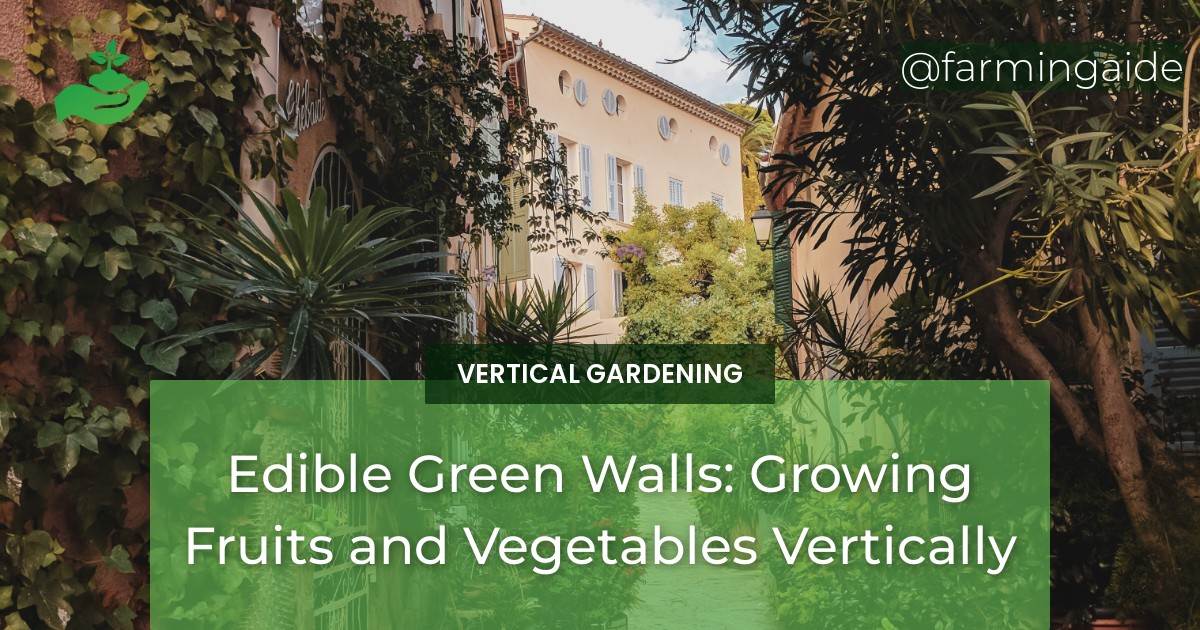Vertical gardening is an exciting way to grow fruits and vegetables in small spaces and utilize walls for your garden. It is an excellent alternative to traditional gardening which requires a lot of space, effort, and time.
This method of gardening is not only practical but also beautiful, as it adds a touch of green to your home. With edible green walls, you can grow fruits and vegetables, not just ornamental plants.
Table of Contents
Suitable Fruits and Vegetables for Vertical Growth
Best Fruits for Vertical Growth
Strawberries:
They are easy to grow, space-saving, and perfect for vertical gardens. They grow well in containers, and you can hang them from a wall or trellis.
Grapes:
Grapes are a good choice for vertical gardens as they can be trained to grow upwards. They require support from a trellis or wires.
Melons:
Melons can be grown vertically in containers or hanging pots. They need a lot of space to grow, so choose a large container or hanging pot.
Best Vegetables for Vertical Growth
Tomatoes:
They are one of the most popular vegetables for vertical gardening. Choose determinate tomato plants as they grow to a certain height and do not require staking.
Cucumbers:
Cucumbers grow well on trellises or in hanging baskets. They require support to climb.
Peppers:
Peppers can be grown in containers, and they do not require a lot of space to grow.
ALSO READ
Designing a Productive Edible Green Wall
Choosing the Right Wall
Choose a wall that receives adequate sunlight for your plants. The amount of sunlight required varies depending on the plants you choose to grow.
Planning the Layout
Plan the layout of your green wall by deciding on the number of plants you want to grow, their spacing, and the type and size of containers you’ll use.
Choosing the Right Containers
Choose containers that are suitable for your plants. Consider the size, shape, and drainage of the containers.
Irrigation and Water Management
Make sure that your green wall receives adequate water. Consider installing a drip irrigation system to ensure that your plants receive the right amount of water.
Lighting Requirements
If the wall you’ve chosen does not receive enough sunlight, consider installing grow lights to provide adequate light for your plants.
Managing Soil and Nutrients for Vertical Edible Gardens
Soil Mixes for Vertical Gardens
Choose a soil mix that is well-draining and provides adequate nutrients for your plants.
Fertilizers for Vertical Gardens
Use fertilizers that are suitable for your plants. Choose organic fertilizers over chemical fertilizers.
Composting for Vertical Gardens
Composting is an excellent way to provide nutrients for your plants. Consider setting up a compost bin to make your compost.
ALSO READ
Harvesting and Maintaining Vertical Edible Gardens
Pruning and Trimming
Prune your plants regularly to encourage growth and maintain their shape.
Pest and Disease Management
Keep an eye out for pests and diseases that can damage your plants. Use natural pest control methods if possible.
Harvesting Techniques
Harvest your fruits and vegetables when they are ripe. Use a sharp knife or scissors to avoid damaging your plants.
Seasonal Planning and Crop Rotation for Vertical Edible Gardens
Choosing the Right Crops for the Season
Choose crops that are suitable for the season you’re in. Cool-season vegetables such as broccoli and lettuce are suitable for fall and winter, while warm-season vegetables such as tomatoes and peppers are suitable for spring and summer.
Crop Rotation Techniques
Rotate your crops to avoid soil-borne diseases and pests.
Winterizing Techniques for Vertical Gardens
Protect your plants from frost by covering them with blankets or moving them indoors.
Conclusion
Vertical edible gardens are an excellent alternative to traditional gardening. With the right planning and maintenance, you can grow a variety of fruits and vegetables in a limited space. Choose the right plants, containers, and soil, and you’ll be on your way to creating a productive and beautiful edible green wall.
RELATED ARTICLES:


